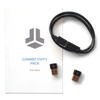
Anyone working with cryptocurrencies has to be rather adept in moving Bitcoin between wallets. Whether you're paying for protection, making a payment, or just rearranging your assets, be sure you do it safely and wisely. I will lead you through the process in this article and provide ideas on choosing the best wallets for your needs, protecting transactions using passphrases, and using hardware wallets.
Step 1: Choose Your Bitcoin Wallet
You firstly require a wallet. Although there are several kinds of Bitcoin wallets on the market, none are made equally. If security is your top goal—especially for long-term storage—a hardware wallet is your greatest friend. Hardware wallets are quite resistant to hackers since they save your private keys offline unlike internet wallets. One excellent choice with amazing security features is the Ledger cold wallet. Whether you go with Ledger or another choice, be sure you are keeping your Bitcoin safe by using one of the best wallets accessible.
Step 2: Get the Recipient’s Wallet Address
You then will need the wallet address of the individual or platform you are forwarding Bitcoin to. Usually, this is a long series of haphazard letters and digits. Though it looks perplexing, in the crypto realm it's essentially like the recipient's bank account number. Verify it double-checked as well! A little error here can send your Bitcoin to the incorrect address; bitcoin transactions cannot be reversed.
Step 3: Enter the Amount and Confirm the Transaction
Decide how much Bitcoin you wish to send once you know the wallet address. You won't have to worry about difficult conversions most wallets will display you how much this is worth in your local currency. Review the transaction a second before you confirm. Before clicking that last "Send," many wallets—including hardware wallets like Ledger—will let you examine all the specifics.
Step 4: Secure Your Transaction with a Passphrase
Should you use a hardware wallet or some other kind of safe wallet, you could be asked to use a passphrase. A passphrase these days differs from your standard wallet password. It's an additional degree of protection that guarantees only you may access your money. Generally speaking, make your passphrase distinctive and put it somewhere safe—probably offline. If you forget it, recovering your funds can be very tricky.
Step 5: Verify and Complete the Transaction
Submitting your transaction comes last once you have verified the quantity and address. Track the status on the blockchain network; depending on network traffic, your Bitcoin should show up in the recipient's wallet minutes to an hour. Remember, occasionally the procedure could run a little slower under heavy traffic.





















































